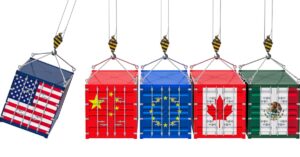The global logistics landscape is once again being reshaped — this time by a fresh wave of U.S. tariffs and the ripple effects they’re creating across supply chains. From manufacturers to freight forwarders, companies are responding to rising costs, shifting strategies, and bracing for more uncertainty ahead. As new duties hit imports and long-standing exemptions expire, once routine decisions — like shipping timelines, freight modes, and sourcing locations — now demand closer scrutiny and faster adaptation.
In this edition, we dive into the most pressing developments: the scramble among shippers to move goods ahead of the sweeping tariff changes, the uncertainty hanging over the air cargo market as low-value imports from China face new fees, and the 10% container drop projected at the Port of Los Angeles due to front-loading and waning demand. While some sectors, like package delivery, see job gains and rising wages, others — particularly small importers — struggle to keep pace with new cost structures and shifting trade routes.
Whether you’re facing rising equipment prices, rethinking sourcing, or exploring new freight options, this month’s news offers a clear look at the challenges and opportunities on the horizon. The stakes are high, but so are the chances to innovate. Let’s get into it.
Tariff Uncertainty Has Shippers Revamping Supply Chains
The Trump administration’s sweeping tariffs on imports from nearly every country are forcing shippers to change how they manage their supply chains. Some shippers were hurrying to move goods before the new tariffs took effect, while others were holding shipments in Asia, hoping that the charges would be lowered. The 90-day pause just has shippers guessing.
Companies are shifting from full container loads to less-than-container loads, booking air freight, and revising terms to reduce duty costs. This sudden change is causing operational uncertainty, and experts worry that it could lead to higher consumer prices and disruptions in trade operations, with U.S. Customs potentially struggling to implement the measures efficiently.
New Duties on Low-Value Imports Spark Air Cargo Concerns
On May 2, the duty-free status for low-value U.S. imports from China and Hong Kong will end. Items valued at or under $800 will face tariffs at 30% of their value or a fixed fee per item that increases after June 1. Shippers in the air cargo market, which have suffered from high rates and limited capacity, may see some relief.
However, concerns over congestion at U.S. airports loom as Customs ramps up processing. The executive order targets practices that allowed illicit goods to slip through under the de minimis exemption. If these duties lower the demand for Chinese e-commerce, additional freighter capacity could ease spot rates, though the overall effects on logistics remain uncertain.
Port of Los Angeles Expects 10% Drop in Container Traffic
The Port of Los Angeles is projected to see a 10% drop in container volumes during the second half of the year. Port officials noted that months of front-loading — in which shippers moved large volumes of goods early — and high import prices have filled inventories with household goods and other staples.
Port Executive Director Gene Seroka explained that once the surplus of cargo is cleared, demand will ease as importers look for lower-cost sourcing alternatives amid rising tariff pressures. He mentioned that higher tariffs have driven companies to rethink their supply chains, prompting some to explore sourcing from countries like Vietnam, Indonesia, and Malaysia.
Although seasonal demand from merchandise and back-to-school products could provide a boost later in the year, the current trend suggests that smaller firms, with less ability to front-load shipments, will be more affected by higher market prices, with these costs eventually passed on to consumers.
Truck Jobs Rise Sharply Amid Mixed Transportation Trends
In March, truck transportation jobs increased by 9,600, marking the largest monthly gain since early 2022, even as overall nonfarm payrolls rose by 228,000. Although current truck employment is slightly lower than a year ago, it is the highest it has been since April 2024.
The jump in hiring was driven by strong gains in the package delivery sector, which added 15,800 jobs. In contrast, warehousing and rail employment saw declines. Warehouse jobs dropped by 9,400, and rail jobs fell by 700. Additionally, nonsupervisory truck drivers have seen hourly wages climb above $30 for four consecutive months, reaching $30.50 in February.
Economic experts note that this spike in truck jobs may be a temporary response following market disruptions earlier this year.
Simplify Shipping With COGISTICS Transportation
Tariffs may or may not negatively impact supply chains and shipping operations. However, they usher in uncertain times. With COGISTICS Transportation, complexity becomes clarity, and logistics becomes a competitive advantage. Leveraging more than 30 years of expertise, we provide innovative, technology-driven logistics solutions, and expedited freight by land, air, and sea — around the clock, around the world. Connect with us today.




